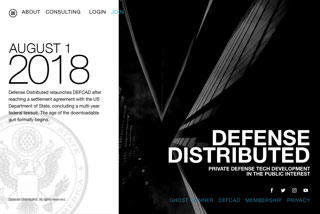If you’re reading this......
....the world probably hasn’t ended, despite the hysterics of twenty one attorneys general, including Josh Shapiro of Pennsylvania and Bob Ferguson of Washington State.
They’ve gone to court in an attempt to protect the rest of us from the distribution of.....
...pornography? Nope.
...scams of senior citizens? Come on.
They’re out to protect us from the distribution of free CAD drawings for 3D printers.
These horrifying CAD files from Defense Distributed could allow you (if you have the technological expertise and a 3-D printer) to print (manufacture) what the media calls “ghost guns.”
The whole controversy began in 2012 when 25-year old law student Cody Wilson posted designs for a single shot pistol made almost entirely of ABS plastic online. It was, he said, his way of proving that the government couldn’t really deny the people access to objects. “In the future,” Wilson said,” they’ll be able to make guns for themselves.”
In May of 2013, Defense Distributed, Wilson’s self-described Wiki project, published a video showing one of their printed pistols being fired.
At that point, the State Department sent a cease-and-desist letter to Wilson, saying his act of posting the design violated ITAR- the International Traffic in Arms Regulations.
The State Department logic was that someone in another country where the United States doesn’t sell weapons could download the materials and make guns.
Wilson complied- but simultaneously notified the government that the plans had already been downloaded 1,000,000 times. (Disclosure: That total included one download I made to see if I could. Don’t know if they were legit, because I lacked a CAD program to open them. That’s likely the same surprise that greeted more than one of the other 999,999 people who downloaded them.)
In 2015, Wilson sued the government, citing his right to free speech. Last month, a settlement agreement was reached. In it, the State Department said it had determined that “certain firearms and related items that are widely available for commercial sales, and technical data related to those items, is of a type that does not offer critical military or intelligence advantage to the United States.”

Today, the Defense Distributed website is set to relaunch, offering what it calls "private defense tech development in the public interest." OWDN screen shot from.defdist.org
|
In short, Wilson hadn’t done anything to compromise modern national security or military superiority.
The settlement said that effective August 1, 2018, Defense Distributed could again post the drawings for download. The ability to print a plastic pistol that more closely resembles the stamped metal, single use pistols the Allies made and dropped to freedom fighters in World War II didn’t compromise our military superiority.
At that point, the gun hysteria machine went into turbo mode.
Why? Ignorance, although some of it is willfull.
The “guns” aren’t “invisible” to X-rays. And despite LA City Attorney Mike Feurer and Manhattan District Attorney Cyrus Vance’s insistence otherwise, they won’t “enable criminals to print untraceable guns on demand.”
In fact, printed guns- due to variables in material and printer quality- might be more dangerous for the shooter than the target. German 3-D printing magazine All3dp, published police testing of a gun from a 3-D printer and concluded it “could endanger the shooter as much as anyone else.”
The ATF’s testing proved it not a gap in qualities, it’s a chasm. One ATF unit printed from ABS-M30 plastic fired eight times when tested. It was classified a “lethal weapon.” Another, printed from plastic called VisiJet, exploded.
Is is possible to “print” a gun?
Yes, absolutely.
I’ve fired a commercial prototype pistol where the majority of their parts were “printed” using commercial 3-D printing. Can’t say one hundred percent of the parts were printed, because the barrel may have been from an earlier version of the pistol.
But it was fired- repeatedly- by several writers (after we were assured that it had already been fired “hundreds” of times before we tried it). It was still running when we finished.
The fact a company with a six-figure manufacturing machine running equally expensive software can “print” parts (metal ones in this case) shouldn’t lead us to jump to the conclusion that we’re about to be overrun with combo crack houses and gun printing offices.
“Printing” is the same term applied to web-press printing newspapers - or kids carving a design into a potato, dipping it in ink and transferring it onto a piece of paper. Same, term, but magnitudes of difference in the level of sophistication.
Ultimately, the real issue isn’t about “printing guns” is (surprise) about rights.
One side says “we already have the ability, we’re concerned about keeping the right, so we’re pressing the issue.”
The other side doesn’t believe individuals have that “right” -but know admitting that wouldn’t be politically advantageous.
Instead, they choose to use hysteria, misinformation, hyperbole and misdirection to attack the technology that they see preventing their successfully regulating the “right”.
Whatever happens with this latest “threat” the real fight is nowhere near over.
And we’ll keep you posted.
--Jim Shepherd